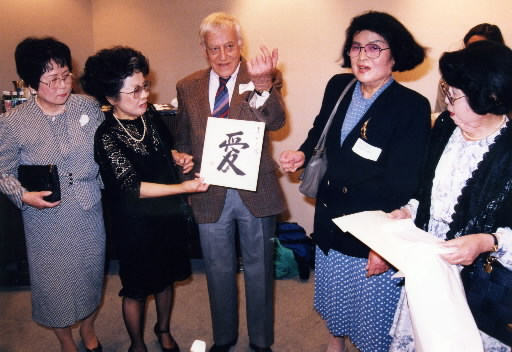Hiroshima Girls, Part 2: Bridging Japan and the United States [1]
Jul. 3, 2010
Reunion with operating surgeon, 40 years later
by Masami Nishimoto, Staff Writer
This feature series on the "Hiroshima Girls," also known as "Hiroshima Maidens," is a close look at a number of Japanese women who were impacted by the atomic bombing of Hiroshima. The series was originally published in 1996.
On the evening of May 9, a small party was held at the Nippon Club on West 57th Street in New York, the city of skyscrapers. This was a reunion for people associated with the "Hiroshima Girls."
Dr. Bernard Simon, 84, was the first to arrive. Looking forward to seeing the former "Hiroshima Girls," Dr. Simon said he is still proud to have played a role in the project which enabled the young women to begin a new chapter in their lives. He was one of the surgeons who performed plastic surgery on the 25 female A-bomb survivors at Mount Sinai Hospital in Manhattan.
Eloise Hicks, 87, a former host mother, also waited for the women quietly. As a Quaker and abiding pacifist, she had agreed to open her home to them. With a cane in her hand, Ms. Hicks smiled and remarked, "All of the girls were so modest and kind."
The deep wrinkles that line their faces illustrate how much time has passed. Not many remain in the United States with firsthand knowledge of the project.
Four women appeared and called to Dr. Simon -- "Doctor," they said -- and, one by one, shared an embrace with him, blinking their eyes.
That day, May 9, happened to coincide with the day they first arrived in New York, with both hope and anxiety in their minds, after suffering from the aftereffects of injuries caused by the heat rays unleashed by the atomic bomb. They came together, 40 years later, in the city which helped them start their lives over.
A work of calligraphy was handed to Dr. Simon from two of the women: Michiko Yamaoka, 66, a resident of Naka Ward, Hiroshima, and Hiroko Tasaka, 64, from the town of Setoda in Hiroshima Prefecture. Ms. Yamaoka has been engaged in activities to convey her A-bomb experience. Ms. Tasaka got married to an American citizen she met through her treatment in the United States. On the back of their calligraphy were the signatures of the eight "girls" from Hiroshima.
"Oh! You have so many girls!" Shigeko Sasamori, 64, said in English, arousing laughter. Ms. Sasamori is now an American citizen and a resident of Los Angeles. Misako Tachibana, 66, who now lives in Canada, said, "I came here because I wanted to share the happiness I now have in my life." The night wore on as they enjoyed renewing old friendships with smile-lit faces.
Ten years after the bombing, citizens of America and Japan joined hands to accomplish a shared endeavor: the medical treatment of "Hiroshima Girls" in the United States, which lasted for a year and a half.
On the day following the reunion, a symposium regarding the medical effort was held in a hall at Mount Sinai Hospital. The symposium, organized by the hospital and a university chartered by the hospital, was designed to provide young medical students with an understanding of the medical care delivered to A-bomb sufferers and to help encourage medical cooperation in the present to promote human rights, social justice, and environmentalism.
Before some 100 listeners, Dr. Simon, the only living doctor among the three operating surgeons, told various anecdotes about the dedication supporters gave to the project and memories related to the girls. Responding to his speech, the four former "Hiroshima Girls" mounted the platform and said, "We've been able to carry on thanks to encounters with many wonderful people." Their speeches expressed sincerity and appreciation, conveying, above all, their heartfelt wishes for peace.
While listening to their stories, one of the medical students in the audience showed a look of surprise and said, "Their accounts of the war were so graphic. How could such a project be carried out when the subject of the atomic bombing was still taboo?"
Half a century after the bombing, Japan and the United States have yet to arrive at a shared view of the event. This series will recount the spirit and undertaking of the project involving the medical treatment of the "Hiroshima Girls," which was also an attempt to bridge the divide rent by the atomic bombing.
(Originally published on July 8, 1996)
Bernard Simon died in 1999 at the age of 87.








